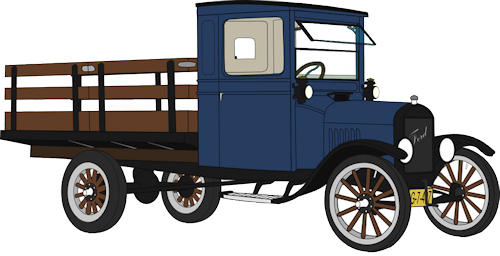

Mobile users:
For best results, view in Landscape mode.
In the early 1800's the
gasoline engine was invented,
it was followed by the first gasoline powered trucks.
These trucks did not have any windshields, doors, or
roofs,
and the drivers had no protection from the elements.
The top speed on these
trucks were a whopping 20 mph.
These
early trucks had a tiller bar instead of a steering wheel.
Also, oil lamps were used for night driving instead of
headlights.
The first commercial vehicle
was made in 1899.
It was powered by a steam engine.
In 1903 the Automobile
Club of America staged the first U.S.
commercial vehicle contest to test the economy, reliability,
durability, speed, and carrying capacity of the truck, the
newest
mode of freight transportation.
By 1908, 4,000 trucks
were in use in the U.S,, transporting
goods of every type wherever streets and roads were
passable.
During 1910, production
of trucks in the U.S. amounted to about
10,000.
In 1916
the Seattle chamber of commerce paid the expense for
a truck to drive from Seattle to New York City.
It took 31 days of actual driving.
By the start 1914 of
World War 1, 300,000 trucks were in use,
and by the war's end 1918 there were more than a
million.
In 1912, a Packard
truck went from New York to San Francisco
in 46 days.
This was the year that trucks were first equipped with
electric lights.
The first truck to
travel from coast to coast was a Sauger, a Swiss
built truck which traveled from Los Angeles to New York in 1911.
In the early 1900's,
trucks were limited for two reasons, first there
weren't very many
paved roads, and second, the trucks used solid
rubber tires.
This type of tire
could be used only at low speeds.
A feature developed around the
time of WW1 that helped the
trucking industry.
During WWI trucks became more
widespread, when manufactures
produced 227,250 trucks to help transport goods for
the war effort.
By 1920 this new tire
became more and more popular.
With the air inflated tire there was much less wear and tear
on
vehicles, so higher speeds were possible.
The driver had a more comfortable ride.
In 1916
the Seattle chamber of commerce paid the expense
for a truck to drive from Seattle to NYC.
It took 31 days of driving time.
In the 1920's the fifth
wheel came along.
In 1920
the semitrailer, whose front end rests on the rear portion
of
the hauling truck
tractor, was gaining in popularity.
In a semitrailer the truck
tractor usually has a disk, known as
the fifth wheel, located on a horizontal platform over its rear wheels;
a pin located under the front of the trailer locks
into this disk,
thus attaching the trailer to the tractor and furnishing support for
the front end of the trailer.
The first tractors powered by
diesel engines were built in
the early 1930's.
1935 Motor
Carrier Act brought
trucking under federal regulations.
The first tilt-cab, or cab-over, truck was built in 1935.
The Federal Government spent
$75 million on construction and
improvement of roads.
There was less
than 15,000 miles of paved highways in the
U.S. in 1914.
In the 1930's,
the number of new trucks registered in the U.S.
totaled some 329,000.
In 1939 Al Gross, founder of the CB, invents the first walkie talky.
In 1943 he made the
first CB radio.
Also in 1943 he began founding the Citizens Band
Corporation.
In 1958 the FCC introduced the first 23
channels of the Citizen Band.
In the 1950's, diesel fuel cost 14.9 cents per gallon.
Conventional trucks in the 1950's
sported a hole in the wall to climb
in to the unheated bunk, which was nothing more than
a shelf
on the wall.
In the 1950's, refrigerated trailers ran on propane.
Trailer lengths started out at 33 feet, gradually increasing
through the
years.
In 1962 Midland CB
Radios introduced into the public market the
first CB radio.
By 1966 Midland
had introduced 21 different mobile CB transceivers.
In 1966, the DOT was
created by an act of Congress.
The DOT became responsible for safety issues.
During the early 1970’s
the oil embargo and the truck strikes pressed
the need for the drivers to communicate to the home base and
the
company that he/she was working for.
In 1977 the FCC
introduced an addition 17 channels to make
the current 40 channels that are available today.
Also, in 1977 the FCC
discontinued the license that was
needed to operate a CB station.
A license is not needed as long as you operate and
follow the
rules and regulations of the FCC.


![]()